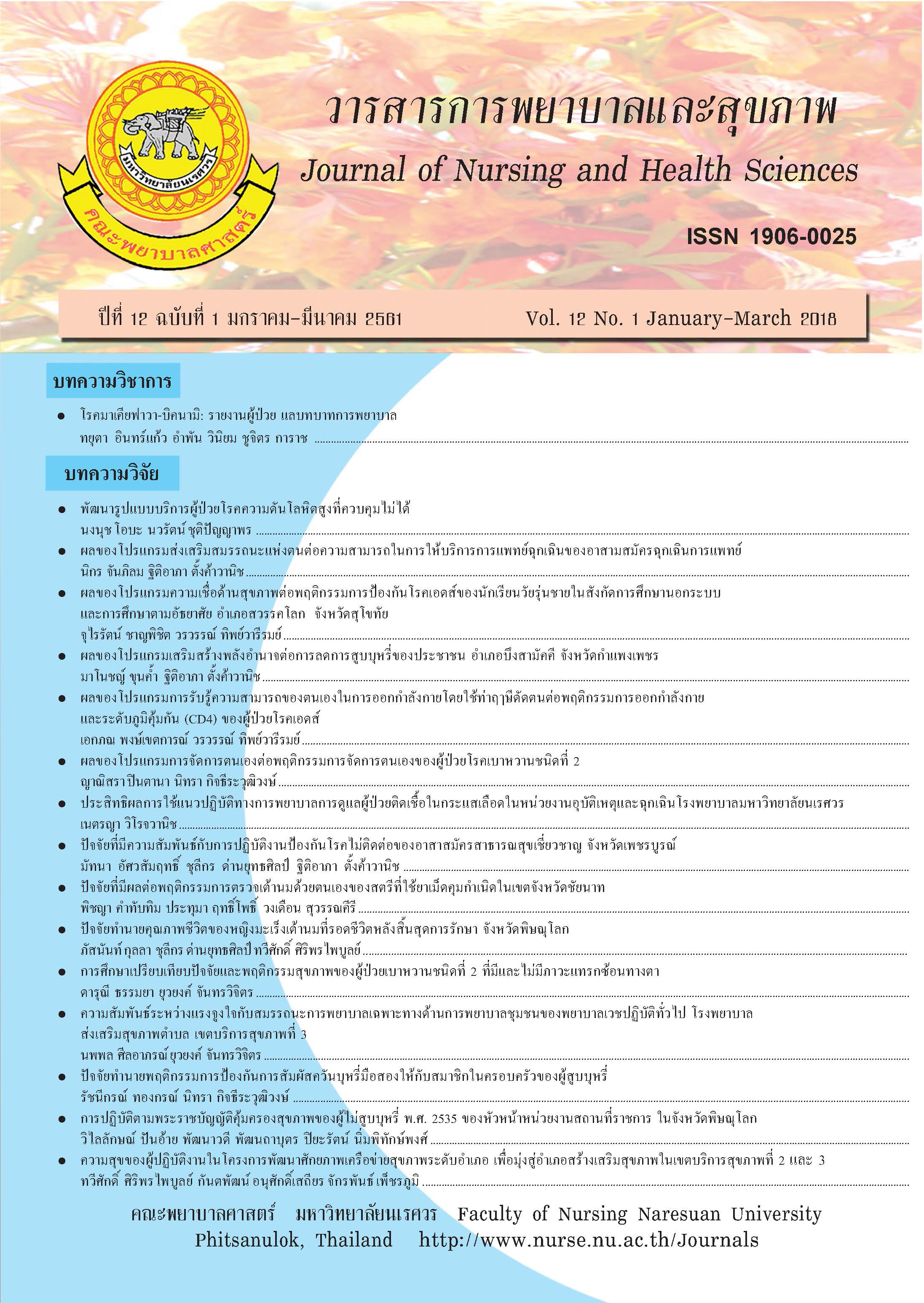The Comparative Study on Factors and Health Behaviors of Type 2 Diabetes Patients With and Without Retinopathy
Main Article Content
Abstract
The objectivesof this researchwere to compare factors and health behaviors of Type 2 Diabetes patients with and without retinopathy. The sample was 378 diabetes with type 2 diabeteswho received treatment and live in Lomsak district, Phetchabun Province. The sample was divided into 2 groups; 189 with retinopathy and 189 without retinopathy. Data were analyzed by using descriptive statistics and Independent t-test. The result revealed that; 1. Overall predisposing factors of Type 2 Diabetes with and without retinopathy were at moderate level. Overall enabling factors betweenthe two groups were at sometime level, and overall reinforcing factors were at frequency level. 2. Overall health behaviors of Type 2 Diabetes with and without retinopathy were at sometime level. 3. Overall predisposing factors and reinforcing factors of Type 2 Diabetes patients with and without retinopathy were not significant difference, but overall enabling factors between 2 groups were statistical difference (p < .01). It was found that resources and accessibility to health service between 2 groups was statistical difference (p < .05). 4. Overall health behaviors between Type 2 Diabetes with and without retinopathy was not significant difference. The result showed that stress management between two groups was statistical difference (p < .05).
Article Details
References
(2556). Knowledge Management. สืบค้นจาก
http://www.western.ac.th/westernnew/facult
yofwestern/fac_page.php?
จีรศักดิ์ เจริญพันธ์ และเฉลิมพล ตันสกุล. (2550).
พฤติกรรมสุขภาพ Health behavior (พิมพ์
ครั้งที่ 5). มหาสารคาม: คลังนาวิทยา.
นิติพล ภูตะโชติ. (2557). พฤติกรรมองค์การ Organizational
Behavior.กรุงเทพฯ: วี.พริ้นต์ (1991).
นุชรี อาบสุวรรณ และนิตยา พันธุเวทย์. (2557). ประเด็น
สารรณรงค์วันเบาหวานโลกปี 2557(ปีงบ
ประมาณ 2558). กรุงเทพฯ:สำนักโรคไม่ติดต่อ
กระทรวงสาธารณสุข.
นงนุช โอบะ. (2555). การสร้างเสริมสุขภาพและ
การป้องกันโรคเบาหวาน. พิษณุโลก: ดาวเงิน
การพิมพ์.
วิชัย เทียนถาวร. (บรรณาธิการ). ( 2556). ระบบการ
เฝ้าระวัง ควบคุม ป้องกัน โรคเบาหวาน
ความดันโลหิตสูง ในประเทศไทย : นโยบาย
สู่การปฏิบัติ. (ม.ป.ท.).
สถาบันวิจัยและประเมินเทคโนโลยีทางการแพทย์
กรมการแพทย์ กระทรวงสาธารณสุข. (2553).
แนวทางเวชปฏิบัติการป้องกันดูแลรักษา
ภาวะแทรกซ้อนจากโรคเบาหวาน(ตาไต
เท้า).กรุงเทพฯ: โอ-วิทย์.
สถาบันวิจัยและประเมินเทคโนโลยีทางการแพทย์
กรมการแพทย์ กระทรวงสาธารณสุข. (2555).
แนวทางการตรวจคัดกรองและดูแลรักษาโรค
เบาหวานเข้าจอประสาทตา. นนทบุรี: โรงพิมพ์
ชุมนุมสหกรณ์การเกษตรแห่งประเทศไทย.
สถาบันวิจัยและประเมินเทคโนโลยีทางการแพทย์
กรมการแพทย์ กระทรวงสาธารณสุข. (2556).
เอกสารข้อมูล:สถานการณ์โรคเบาหวาน/ความ
ดันโลหิตสูงและภาวะแทรกซ้อนในประเทศ
ไทย Version 1.3. สืบค้นจาก http://www.dms.
moph.go.th/imrta/images/data/doc_dm_ht.pdf
สมาคมโรคเบาหวานแห่งประเทศไทย. (2554).
แนวทางเวชปฏิบัติสำหรับโรคเบาหวาน 2554.
กรุงเทพฯ: ศรีเมืองการพิมพ์.
สำนักโรคไม่ติดต่อ กรมควบคุมโรค กระทรวงสาธารณสุข.
(2559). ANNUAL REPORT 2015 รายงาน
ประจำปี 2558.นนทบุรี: โรงพิมพ์องค์การ
สงเคราะห์ทหารผ่านศึกในพระบรมราชูปถัมภ์.
สุพานี สฤษฎ์วานิช. (2552). พฤติกรรมองค์กรสมัยใหม่
: แนวคิดและทฤษฎี.(พิมพ์ครั้งที่ 2). ปทุมธานี:
โรงพิมพ์มหาวิทยาลัยธรรมศาสตร์.
เสาวคนธ์ แสงนวล. (2557). เอกสารการดำเนินงาน
ป้องกันควบคุมโรคไม่ติดต่อเรื้อรังปี 2557
เครือข่ายบริการสุขภาพ อำเภอหล่มสักจังหวัด
เพชรบูรณ์. เพชรบูรณ์: สำนักงานสาธารณสุข
จังหวัดเพชรบูรณ์. (ม.ป.ท.)
Green, L.W. and Kreuter, M.W. (2005). Health program
planning: An educational andecological
approach(4th ed.). Boston: MacGrawHill.
World Health Organization. (2015).Media centre:
Diabetes 2000-2012. Retrieved from http://www.
who.int/mediacentre/factsheets/fs312/en 1


